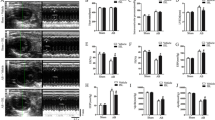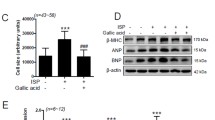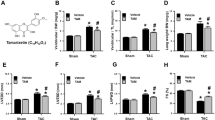Abstract
Isorhamnetin, a flavonoid compound extracted from the Chinese herb Hippophae rhamnoides L., is well known for its anti-inflammatory, anti-oxidative, anti-adipogenic, anti-proliferative, and anti-tumor activities. However, the role of isorhamnetin in cardiac hypertrophy has not been reported. The aims of the present study were to find whether isorhamnetin could alleviate cardiac hypertrophy and to define the underlying molecular mechanisms. Here, we investigated the effects of isorhamnetin (100 mg/kg/day) on cardiac hypertrophy induced by aortic banding in mice. Cardiac hypertrophy was evaluated by echocardiographic, hemodynamic, pathological, and molecular analyses. Our data demonstrated that isorhamnetin could inhibit cardiac hypertrophy and fibrosis 8 weeks after aortic banding. The results further revealed that the effect of isorhamnetin on cardiac hypertrophy was mediated by blocking the activation of phosphatidylinositol 3-kinase–AKT signaling pathway. In vitro studies performed in neonatal rat cardiomyocytes confirmed that isorhamnetin could attenuate cardiomyocyte hypertrophy induced by angiotensin II, which was associated with phosphatidylinositol 3-kinase–AKT signaling pathway. In conclusion, these data indicate for the first time that isorhamnetin has protective potential for targeting cardiac hypertrophy by blocking the phosphatidylinositol 3-kinase–AKT signaling pathway. Thus, our study suggests that isorhamnetin may represent a potential therapeutic strategy for the treatment of cardiac hypertrophy and heart failure.






Similar content being viewed by others
Change history
06 November 2021
A Correction to this paper has been published: https://doi.org/10.1007/s11010-021-04288-x
References
Chen K, Gao L, Liu Y, Zhang Y, Jiang DS, Wei X et al (2013) Vinexin-β protects against cardiac hypertrophy by blocking the Akt-dependent signalling pathway. Basic Res Cardiol 108:338
Tamargo J, Lopez-Sendon J (2011) Novel therapeutic targets for the treatment of heart failure. Nat Rev Drug Discov 10:536–555
Koitabashi N, Kass DA (2012) Reverse remodeling in heart failure–mechanisms and therapeutic opportunities. Nat Rev Cardiol 9:147–157
Heineke J, Molkentin JD (2006) Regulation of cardiac hypertrophy by intracellular signalling pathways. Nat Rev Mol Cell Biol 7:589–600
Lorell BH, Carabello BA (2000) Left ventricular hypertrophy: pathogenesis, detection, and prognosis. Circulation 102:470–479
Dorn GW 2nd, Force T (2005) Protein kinase cascades in the regulation of cardiac hypertrophy. J Clin Invest 115:527–537
Gao L, Huang K, Jiang DS, Liu X, Huang D, Li H et al (2015) Novel role for caspase-activated DNase in the regulation of pathological cardiac hypertrophy. Hypertension 65:871–881
Tang Q, Cai J, Shen D, Bian Z, Yan L, Wang YX et al (2009) Lysosomal cysteine peptidase cathepsin L protects against cardiac hypertrophy through blocking AKT/GSK3beta signaling. J Mol Med 87:249–260
Yan L, Huang H, Tang QZ, Zhu LH, Wang L, Liu C et al (2010) Breviscapine protects against cardiac hypertrophy through blocking PKC-alpha-dependent signaling. J Cell Biochem 109:1158–1171
Ai W, Zhang Y, Tang QZ, Yan L, Bian ZY, Liu C et al (2010) Silibinin attenuates cardiac hypertrophy and fibrosis through blocking EGFR-dependent signaling. J Cell Biochem 110:1111–1122
Park JC, Young HS, Yu YB, Lee JH (1995) Isorhamnetin sulphate from the leaves and stems of Oenanthe javanica in Korea. Planta Med 61:377–378
Yang JH, Kim SC, Shin BY, Jin SH, Jo MJ, Jegal KH et al (2013) O-Methylated flavonol isorhamnetin prevents acute inflammation through blocking of NF-kappaB activation. Food Chem Toxicol 59:362–372
Teng BS, Lu YH, Wang ZT, Tao XY, Wei DZ (2006) In vitro anti-tumor activity of isorhamnetin isolated from Hippophae rhamnoides L. against BEL-7402 cells. Pharmacol Res 54:186–194
Yang JH, Shin BY, Han JY, Kim MG, Wi JE, Kim YW et al (2014) Isorhamnetin protects against oxidative stress by activating Nrf2 and inducing the expression of its target genes. Toxicol Appl Pharmacol 274:293–301
Zhang N, Pei F, Wei H, Zhang T, Yang C, Ma G et al (2011) Isorhamnetin protects rat ventricular myocytes from ischemia and reperfusion injury. Exp Toxicol Pathol 63:33–38
Sun B, Sun GB, Xiao J, Chen RC, Wang X, Wu Y et al (2012) Isorhamnetin inhibits H(2)O(2)-induced activation of the intrinsic apoptotic pathway in H9c2 cardiomyocytes through scavenging reactive oxygen species and ERK inactivation. J Cell Biochem 113:473–485
Sun J, Sun G, Meng X, Wang H, Luo Y, Qin M et al (2013) Isorhamnetin protects against doxorubicin-induced cardiotoxicity in vivo and in vitro. PLoS ONE 8:e64526
Bao M, Lou Y (2006) Isorhamnetin prevent endothelial cell injuries from oxidized LDL via activation of p38MAPK. Eur J Pharmacol 547:22–30
Qiu S, Sun G, Zhang Y, Li X, Wang R (2016) Involvement of the NF-kappaB signaling pathway in the renoprotective effects of isorhamnetin in a type 2 diabetic rat model. Biomed Rep 4:628–634
Kim JE, Lee DE, Lee KW, Son JE, Seo SK, Li J et al (2011) Isorhamnetin suppresses skin cancer through direct inhibition of MEK1 and PI3-K. Cancer Prev Res 4:582–591
Hu S, Huang L, Meng L, Sun H, Zhang W, Xu Y (2015) Isorhamnetin inhibits cell proliferation and induces apoptosis in breast cancer via Akt and mitogen-activated protein kinase kinase signaling pathways. Mol Med Rep 12:6745–6751
Li C, Yang X, Chen C, Cai S, Hu J (2014) Isorhamnetin suppresses colon cancer cell growth through the PI3KAktmTOR pathway. Mol Med Rep 9:935–940
Luo Y, Sun G, Dong X, Wang M, Qin M, Yu Y, et al (2015) Isorhamnetin attenuates atherosclerosis by inhibiting macrophage apoptosis via pi3k/akt activation and HO-1 induction. PloS ONE 10: e0120259
Jiang DS, Luo YX, Zhang R, Zhang XD, Chen HZ, Zhang Y et al (2014) Interferon regulatory factor 9 protects against cardiac hypertrophy by targeting myocardin. Hypertension 63:119–127
Jiang DS, Bian ZY, Zhang Y, Zhang SM, Liu Y, Zhang R et al (2013) Role of interferon regulatory factor 4 in the regulation of pathological cardiac hypertrophy. Hypertension 61:1193–1202
Konhilas JP, Boucek DM, Horn TR, Johnson GL, Leinwand LA (2010) The role of MEKK1 in hypertrophic cardiomyopathy. Int Heart J 51:277–284
Zhang Y, Zhang XF, Gao L, Liu Y, Jiang DS, Chen K et al (2014) Growth/differentiation factor 1 alleviates pressure overload-induced cardiac hypertrophy and dysfunction. Biochim Biophys Acta 1842:232–244
Aoyagi T, Matsui T (2011) Phosphoinositide-3 kinase signaling in cardiac hypertrophy and heart failure. Curr Pharm Des 17:1818–1824
DeBosch B, Sambandam N, Weinheimer C, Courtois M, Muslin AJ (2006) Akt2 regulates cardiac metabolism and cardiomyocyte survival. J Biol Chem 281:32841–32851
Sugden PH, Fuller SJ, Weiss SC, Clerk A (2008) Glycogen synthase kinase 3 (GSK3) in the heart: a point of integration in hypertrophic signalling and a therapeutic target? A critical analysis. Br J Pharmacol 153:S137–S153
Clemente CF, Xavier-Neto J, Dalla Costa AP, Consonni SR, Antunes JE, Rocco SA et al (2012) Focal adhesion kinase governs cardiac concentric hypertrophic growth by activating the AKT and mTOR pathways. J Mol Cell Cardiol 52:493–501
Yang Z, Ming XF (2012) mTOR signalling: the molecular interface connecting metabolic stress, aging and cardiovascular diseases. Obes Rev 13(Suppl 2):58–68
Kenessey A, Ojamaa K (2006) Thyroid hormone stimulates protein synthesis in the cardiomyocyte by activating the Akt-mTOR and p70S6K pathways. J Biol Chem 281:20666–20672
Davies SP, Reddy H, Caivano M, Cohen P (2000) Specificity and mechanism of action of some commonly used protein kinase inhibitors. Biochem J 351:95–105
Jacobs MD, Black J, Futer O, Swenson L, Hare B, Fleming M et al (2005) Pim-1 ligand-bound structures reveal the mechanism of serine/threonine kinase inhibition by LY294002. J Biol Chem 280:13728–13734
Chen L, Han L, Shi Z, Zhang K, Liu Y, Zheng Y, et al (2012) LY294002 enhances cytotoxicity of temozolomide in glioma by down-regulation of the PI3K/Akt pathway. Mol Med Rep 5:575–579
Liu P, Xu B, Li J, Lu H (2008) LY294002 inhibits leukemia cell invasion and migration through early growth response gene 1 induction independent of phosphatidylinositol 3-kinase-Akt pathway. Biochem Biophys Res Commun 377:187–190
Acknowledgements
This work was supported by a Grant from the The First Affiliated Hospital of Zhengzhou University.
Author contributions
Lu Gao, Rui Yao, and Yanzhou Zhang conceived and designed the research; Lu Gao, Yuzhou Liu, and Zheng Wang performed experiments; Lu Gao, Zhen Huang, and Zhen Huang analyzed data; Lu Gao and Binbin Du interpreted the results of experiments; Dianhong Zhang, and Leiming Wu prepared figures; Lu Gao drafted the manuscript; Rui Yao and Yanzhou Zhang edited and revised the manuscript; Lu Gao, Rui Yao, Yuzhou Liu, Zheng Wang, Zhen Huang, Binbin Du, Dianhong Zhang, Leiming Wu, Lili Xiao, and Yanzhou Zhang approved the final version of manuscript.
Author information
Authors and Affiliations
Corresponding author
Additional information
Lu Gao, Rui Yao, and Yuzhou Liu are the co-first authors.
Electronic supplementary material
Below is the link to the electronic supplementary material.
Rights and permissions
About this article
Cite this article
Gao, L., Yao, R., Liu, Y. et al. Isorhamnetin protects against cardiac hypertrophy through blocking PI3K–AKT pathway. Mol Cell Biochem 429, 167–177 (2017). https://doi.org/10.1007/s11010-017-2944-x
Received:
Accepted:
Published:
Issue Date:
DOI: https://doi.org/10.1007/s11010-017-2944-x




